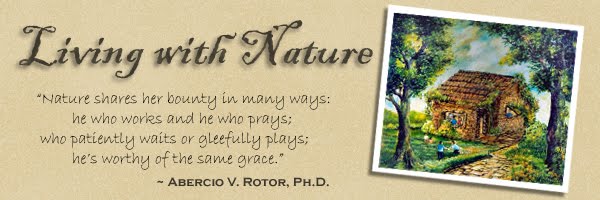Dr Abe V Rotor
 With
practically all available flatlands now placed under cultivation or
made into other uses, one of the last frontiers in agriculture is the
rolling and sloping land. There is a technology called SALT or Sloping
Agricultural Land Technology which the Department of Agriculture has
developed. Other countries have similar programs like ours.
With
practically all available flatlands now placed under cultivation or
made into other uses, one of the last frontiers in agriculture is the
rolling and sloping land. There is a technology called SALT or Sloping
Agricultural Land Technology which the Department of Agriculture has
developed. Other countries have similar programs like ours.In this model runoff water slows down and in the process is absorbed and used by the crops. Trees bind soil and minimize soil erosion. They form a natural riprap along the contour of the field, functioning like levees or dikes of terraces. The cash crops between the trees are protected in turn from siltation, direct wind and sunlight. This alternate cropping of permanent and annual crops is recommended for sloping lands up to 30 degrees.
 The coastal forest mainly composed of mangrove or Rhizophora trees
is the counterpart of the forest inland and on hillsides and mountains.
It forms a natural buffer against the raging sea, particularly in the
event that tidal wave, or worse - tsunami - strikes. Together with the
adjoining coral reef and seagrass, the mangrove is the sanctuary of
marine and estuarine life.
The coastal forest mainly composed of mangrove or Rhizophora trees
is the counterpart of the forest inland and on hillsides and mountains.
It forms a natural buffer against the raging sea, particularly in the
event that tidal wave, or worse - tsunami - strikes. Together with the
adjoining coral reef and seagrass, the mangrove is the sanctuary of
marine and estuarine life.Converting mangrove into fishpond, which is a common practice, destroys this vital ecological function. What is recommended instead is mangrove farming to expand the wildlife sanctuary, and on the shallow portion of the sea shelf, seaweed farming is recommended, so with fish culture in cages but on a limited scale so as not to disturb the ecology of the place.
 Batangas,
Cavite and Laguna are leading provinces when it comes to storey
cropping. It is because of the fair climate with very short dry season,
as well as the fertility of the soil being volcanic in origin. Multiple
cropping is motivated by market demand, these provinces being accessible
to Metro Manila, the biggest market for farm products in the country.
Batangas,
Cavite and Laguna are leading provinces when it comes to storey
cropping. It is because of the fair climate with very short dry season,
as well as the fertility of the soil being volcanic in origin. Multiple
cropping is motivated by market demand, these provinces being accessible
to Metro Manila, the biggest market for farm products in the country.In this model the plants are categorized by their relative heights, seasonality, as well as their water and nutrient requirements, care being practiced to reduce direct competition between and among crops. Actually this model is patterned after the typical profile of the tropical rainforest, which on close examination is basically made of four to five storeys - which is the design of a pyramidal of multistorey cropping system.
 In
ecology the rule is to tailor the crops and other enterprises to the
land, and never the other way around. In short, don't alter the
landscape, don't change nature to fit with your design. Thus, in this
model, the land is ideally managed by heeding its topography, water
regime, soil type and fertility, and the like. A great advantage in this
illustrated model is the unity and harmony of three parts of the areas
that lend to the culture of three general commodities, each supporting
one another. Here recycling is feasible. There is always work the year
round. The farm is a recreation and park at the same time, indeed ideal
for growing children, and lovers of nature. You are also creating a
wildlife sanctuary in the farm. It is ecological farming in the true
sense. ~
In
ecology the rule is to tailor the crops and other enterprises to the
land, and never the other way around. In short, don't alter the
landscape, don't change nature to fit with your design. Thus, in this
model, the land is ideally managed by heeding its topography, water
regime, soil type and fertility, and the like. A great advantage in this
illustrated model is the unity and harmony of three parts of the areas
that lend to the culture of three general commodities, each supporting
one another. Here recycling is feasible. There is always work the year
round. The farm is a recreation and park at the same time, indeed ideal
for growing children, and lovers of nature. You are also creating a
wildlife sanctuary in the farm. It is ecological farming in the true
sense. ~

No comments:
Post a Comment